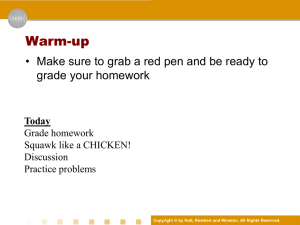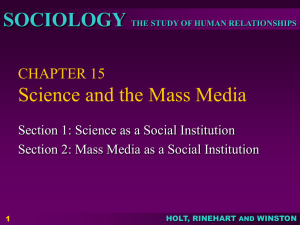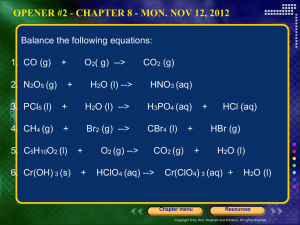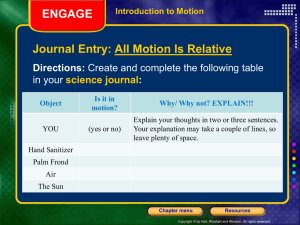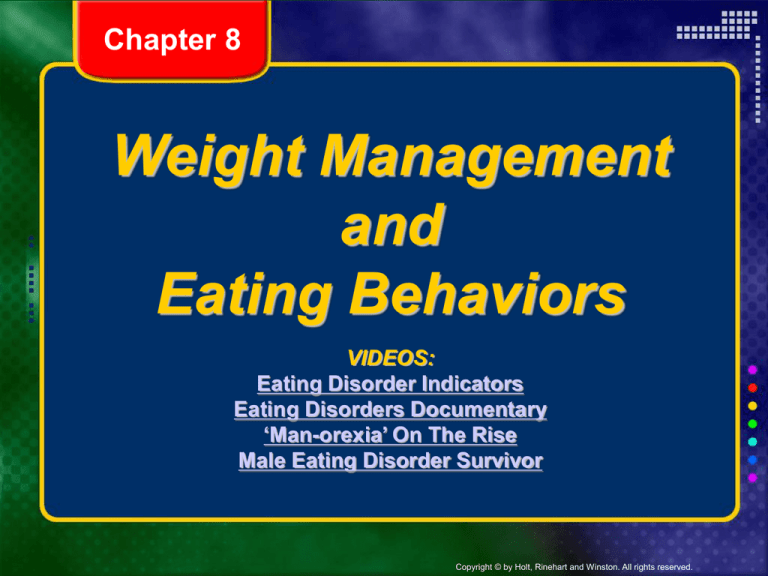
Chapter 8
Weight Management
and
Eating Behaviors
VIDEOS:
Eating Disorder Indicators
Eating Disorders Documentary
‘Man-orexia’ On The Rise
Male Eating Disorder Survivor
Copyright © by Holt, Rinehart and Winston. All rights reserved.
1.
2.
3.
4.
5.
6.
7.
ANSWERS:
TRUE
TRUE
TRUE
FALSE—a weight
management program
includes healthy
eating & exercise
habits that maintain a
healthy weight.
TRUE
TRUE
FALSE—most foodborne illnesses are
caused by foods that
are prepared or eaten
at home.
Copyright © by Holt, Rinehart and Winston. All rights reserved.
Chapter 8
Weight Management
and
Eating Behaviors
Contents
•
•
•
•
Section 1 Food and Your Body Weight
Section 2 Maintaining a Healthy Weight
Section 3 Eating Disorders
Section 4 Preventing Food-Related Illnesses
Copyright © by Holt, Rinehart and Winston. All rights reserved.
Chapter 8
Weight Management and Eating
Behaviors
Section 1
Food and Your Body Weight
Copyright © by Holt, Rinehart and Winston. All rights reserved.
Chapter 8
Section 1 Food and Your Body
Weight
VOCAB
HUNGER: the body’s need for food.
APPETITE: the desire to eat particular foods.
Copyright © by Holt, Rinehart and Winston. All rights reserved.
Chapter 8
Section 1 Food and Your Body
Weight
Why Do You Eat?
• The amount and type of food you eat depend on
many factors, including:
• The smell and taste of food
• Mood
• Family, ethnic, and religious traditions
• Social occasions
• Health concerns
• Advertising
• Cost and availability
Copyright © by Holt, Rinehart and Winston. All rights reserved.
Chapter 8
Section 1 Food and Your Body
Weight
Food Provides Energy (CALORIES)
1. The amount of calories in food depends on the
amount of carbohydrates, fats, and proteins.
2. Extra calories that you do not immediately use are
stored as glycogen or fat.
3. Breakfast activates your body and brain at the start
of the day.
Copyright © by Holt, Rinehart and Winston. All rights reserved.
Chapter 8
Section 1 Food and Your Body
Weight
VOCAB
• BASAL METABOLIC RATE (BMR): the amount of
energy your body uses for basic functions
(breathing, heartbeat, digestion, etc).
•varies from person to person, depending on:
•Age
•Weight
•Sex
•Activity level
Copyright © by Holt, Rinehart and Winston. All rights reserved.
Chapter 8
Section 1 Food and Your Body
Weight
Balancing Energy Intake with Energy Used
• Some body fat is essential for health
• 4% of total body weight for males
• 10% of total body weight for females
• ENERGY BALANCE: when the food energy you
take in equals the energy you use.
• Extra food energy increases the body fat and causes
weight gain.
Copyright © by Holt, Rinehart and Winston. All rights reserved.
Chapter 8
Section 1 Food and Your Body
Weight
Being overweight increases the risk of
many long-term health problems, including:
•
•
•
•
Heart disease and high blood pressure
Prostate, colon, and breast cancer
Type 2 diabetes
Sleeping problems such as sleep apnea
Copyright © by Holt, Rinehart and Winston. All rights reserved.
Chapter 8
Section 1 Food and Your Body
Weight
Overweight and Obesity: A Growing Problem
Obesity: being more than 20% over your
recommended weight.
1. More Americans are obese now than ever before.
2. Americans today exercise less and eat more foods
high in sugar and fat than in the past.
3. Exercise and a healthy diet can help most people
stay in a healthy weight range.
Copyright © by Holt, Rinehart and Winston. All rights reserved.
Copyright © by Holt, Rinehart and Winston. All rights reserved.
Chapter 8
Weight Management and Eating
Behaviors
Section 2
Maintaining a Healthy Weight
Copyright © by Holt, Rinehart and Winston. All rights reserved.
Copyright © by Holt, Rinehart and Winston. All rights reserved.
Chapter 8
Section 2 Maintaining a Healthy
Weight
Bellringer:
What are some popular diets that you have heard of?
Do you think these diets are safe and effective?
Copyright © by Holt, Rinehart and Winston. All rights reserved.
Chapter 8
Section 2 Maintaining a Healthy
Weight
Why Do You Weigh What You Weigh?
• HEREDITY: the passing down of traits from parent
to child through DNA.
• Whether you gain or lose weight easily is
largely due to heredity.
• CHOICES about…
• what you eat,
• how much you eat, and
• how much you exercise…
affect your energy balance and body weight.
Copyright © by Holt, Rinehart and Winston. All rights reserved.
Copyright © by Holt, Rinehart and Winston. All rights reserved.
Copyright © by Holt, Rinehart and Winston. All rights reserved.
Chapter 8
Section 2 Maintaining a Healthy
Weight
What Is a Healthy Weight For ME?
• BODY COMPOSITION:
% body weight from fat
-vs% body weight from bone and muscle
• Someone can be overweight without being obese,
depending on their body composition.
• BODY MASS INDEX (BMI) = index of weight in
relation to height that is used to assess healthy body
weight.
Copyright © by Holt, Rinehart and Winston. All rights reserved.
Copyright © by Holt, Rinehart and Winston. All rights reserved.
Chapter 8
Section 2 Maintaining a Healthy
Weight
A Healthy Weight Management Plan
• Healthy Weight Management: a program of
eating and exercise that keep weight at a healthy
level.
• Keys to healthy weight management:
• eat better (nutrient dense foods)
• eat less (portion control)
• exercise more (be active)
• The goal is to lose fat, not muscle.
Copyright © by Holt, Rinehart and Winston. All rights reserved.
Chapter 8
Section 2 Maintaining a Healthy
Weight
A Healthy Weight Management Plan
• To lose 1 pound of fat = - 3,500 cal energy balance
• Safe weight loss: 2-3 pounds per week
• >3 lbs / week weight loss is unhealthy and too
calorie-restrictive
Copyright © by Holt, Rinehart and Winston. All rights reserved.
Copyright © by Holt, Rinehart and Winston. All rights reserved.
Copyright © by Holt, Rinehart and Winston. All rights reserved.
Chapter 8
Section 2 Maintaining a Healthy
Weight
A Healthy Weight Management Plan (cont)
• You can safely gain weight by gradually increasing
food intake and by exercising to increase muscle
mass (strength and resistance training).
• If you are underweight, consult a doctor to make sure
your low weight is not due to an illness or other
condition.
Copyright © by Holt, Rinehart and Winston. All rights reserved.
Chapter 8
Section 2 Maintaining a Healthy
Weight
Dangerous Weight-Loss Practices
• Many weight-loss products and programs fail to
provide healthy long-term weight management.
• Fad diets (ignores some nutrient requirements)
• Diet pills (unhealthy / dangerous side effects)
• Surgery (risk, life-altering change)
• The only safe and reliable way to manage your
weight is to balance food intake with exercise.
Copyright © by Holt, Rinehart and Winston. All rights reserved.
Copyright © by Holt, Rinehart and Winston. All rights reserved.
Chapter 8
Weight Management and Eating
Behaviors
Section 3
Eating Disorders
Copyright © by Holt, Rinehart and Winston. All rights reserved.
Chapter 8
Section 3 Eating Disorders
Bellringer
• Students should close their eyes and consider the
following…
• Think about your ideal body image.
• Think about your actual body image.
• How do the two descriptions differ?
• Do you think your ideal image is healthy?
• Do you think it is healthier than your actual image?
Copyright © by Holt, Rinehart and Winston. All rights reserved.
Chapter 8
Section 3 Eating Disorders
What Are Eating Disorders?
• Body image: how you feel about your appearance
and body.
• Eating disorders:
• involve an unhealthy degree of concern about
body weight and shape
• may lead to efforts to control weight by
unhealthy means.
• Culture and society: affect what we think of as a
perfect body.
Copyright © by Holt, Rinehart and Winston. All rights reserved.
Chapter 8
Section 3 Eating Disorders
A Closer Look at Eating Disorders
Factors that can contribute to eating disorders:
•
•
•
•
•
•
Body image
Genetics
Culture
Personality
Emotions
Family
Copyright © by Holt, Rinehart and Winston. All rights reserved.
Chapter 8
Section 3 Eating Disorders
A Closer Look at Eating Disorders
• If you have concerns about food or your appearance
that have led to trouble in school, at home, or with
your friends, consult a parent, doctor, or other trusted
adult.
• If you think a friend has an eating disorder, tell your
friend about your concern, and help him or her to
face the problem. Contact an adult if necessary.
Copyright © by Holt, Rinehart and Winston. All rights reserved.
Copyright © by Holt, Rinehart and Winston. All rights reserved.
Copyright © by Holt, Rinehart and Winston. All rights reserved.
Chapter 8
Section 3 Eating Disorders
**Signs and Symptoms of Eating Disorders**
The following signs and symptoms are characteristic of
someone with an eating disorder. Indicate “A” for
anorexia, “B” for bulimia, or “A+B” for both.
Low-calorie dieting that is carried to an extreme?
Very low body weight?
Preoccupation with body weight?
Distorted body image?
Frequent use of laxatives?
Body is in a constant state of starvation?
Binge-purge cycle?
Refuses to eat?
Low self-esteem?
A
A
A+B
A+B
B
A
B
A
A+B
Copyright © by Holt, Rinehart and Winston. All rights reserved.
Chapter 8
Section 3 Eating Disorders
Anorexia Video
Bulimia Video
(5:48)
(6:25)
Copyright © by Holt, Rinehart and Winston. All rights reserved.
Chapter 8
Weight Management and Eating
Behaviors
Section 4
Preventing Food-Related Illnesses
Copyright © by Holt, Rinehart and Winston. All rights reserved.
Chapter 8
Section 4 Preventing Food-Related
Illnesses
Bellringer
• What steps do you take when preparing food?
• Does your list of steps include washing:
• your hands?
• the cooking surfaces?
• the food?
• the utensils?
Copyright © by Holt, Rinehart and Winston. All rights reserved.
Chapter 8
Section 4 Preventing Food-Related
Illnesses
A. Food and Digestive Problems
1. Heartburn: stomach acid leaking into the
esophagus.
Symptoms:
• burning in your chest
Caused by:
• overeating high-fat or spicy foods
• stress and anxiety
Prevention:
• avoiding high-fat or spicy foods
• reducing stress and anxiety
Copyright © by Holt, Rinehart and Winston. All rights reserved.
Chapter 8
Section 4 Preventing Food-Related
Illnesses
A. Food and Digestive Problems
2. Ulcers: open sores in the lining of the stomach or
intestines.
Symptoms:
• They can cause pain after eating
Caused by:
• bacterial infections
• stress
• unhealthy diet
Treatment:
• antibiotics
Copyright © by Holt, Rinehart and Winston. All rights reserved.
Chapter 8
Section 4 Preventing Food-Related
Illnesses
A. Food and Digestive Problems
3. Flatulence: produced by bacteria in the large
intestine when you eat certain indigestible foods.
4. Diarrhea: prolonged diarrhea can cause severe
and dangerous dehydration.
5. Constipation: can be prevented by exercise,
drinking lots of water, and eating a high-fiber diet.
Copyright © by Holt, Rinehart and Winston. All rights reserved.
Chapter 8
Section 4 Preventing Food-Related
Illnesses
B. Food Allergies
•
•
•
•
•
•
•
Examples: peanuts, shellfish, etc…
an abnormal response to a food
relatively rare
triggered by the body’s immune system
see a doctor if you think you have a food allergy
best way to prevent—avoid foods you’re allergic to
people with serious food allergies may need to carry
epinephrine injections to prevent fatal reactions
Copyright © by Holt, Rinehart and Winston. All rights reserved.
Chapter 8
Section 4 Preventing Food-Related
Illnesses
C. Food Intolerances
• conditions that involve bad reactions to food
• Differs from true food allergies, in that the immune
system does not attack your own body
• Example: Lactose intolerance
•Reduced ability to digest the sugar lactose, which
is found in dairy products.
•Treatment and management includes avoiding
dairy intake or using products with the lactase
enzyme added (Lactaid, etc)
Copyright © by Holt, Rinehart and Winston. All rights reserved.
Chapter 8
Section 4 Preventing Food-Related
Illnesses
D. Food-Borne Illness
• Examples: salmonella, botulism, etc…
• Caused by eating or drinking something that contains
a toxin or disease-causing organism
• Common symptoms include nausea, vomiting, and
diarrhea
• Often mistaken for stomach flu
• usually can be treated with rest and lots of fluids
• If symptoms are severe (vomiting & diarrhea lasting
more than 2 days) you should see a doctor
Copyright © by Holt, Rinehart and Winston. All rights reserved.
Chapter 8
Section 4 Preventing Food-Related
Illnesses
D. Food-Borne Illness
• Prevention:
• proper selection, storage, handling, and cooking
of food.
•Replace and wash dishcloths frequently
•Keep your refrigerator cold enough (~40 F)
•Wash hands, utensils, and surfaces with warm,
soapy water between each step
•Cook food thoroughly (to recommended
temperatures)
Copyright © by Holt, Rinehart and Winston. All rights reserved.
End of Chapter 8
Copyright © by Holt, Rinehart and Winston. All rights reserved.

